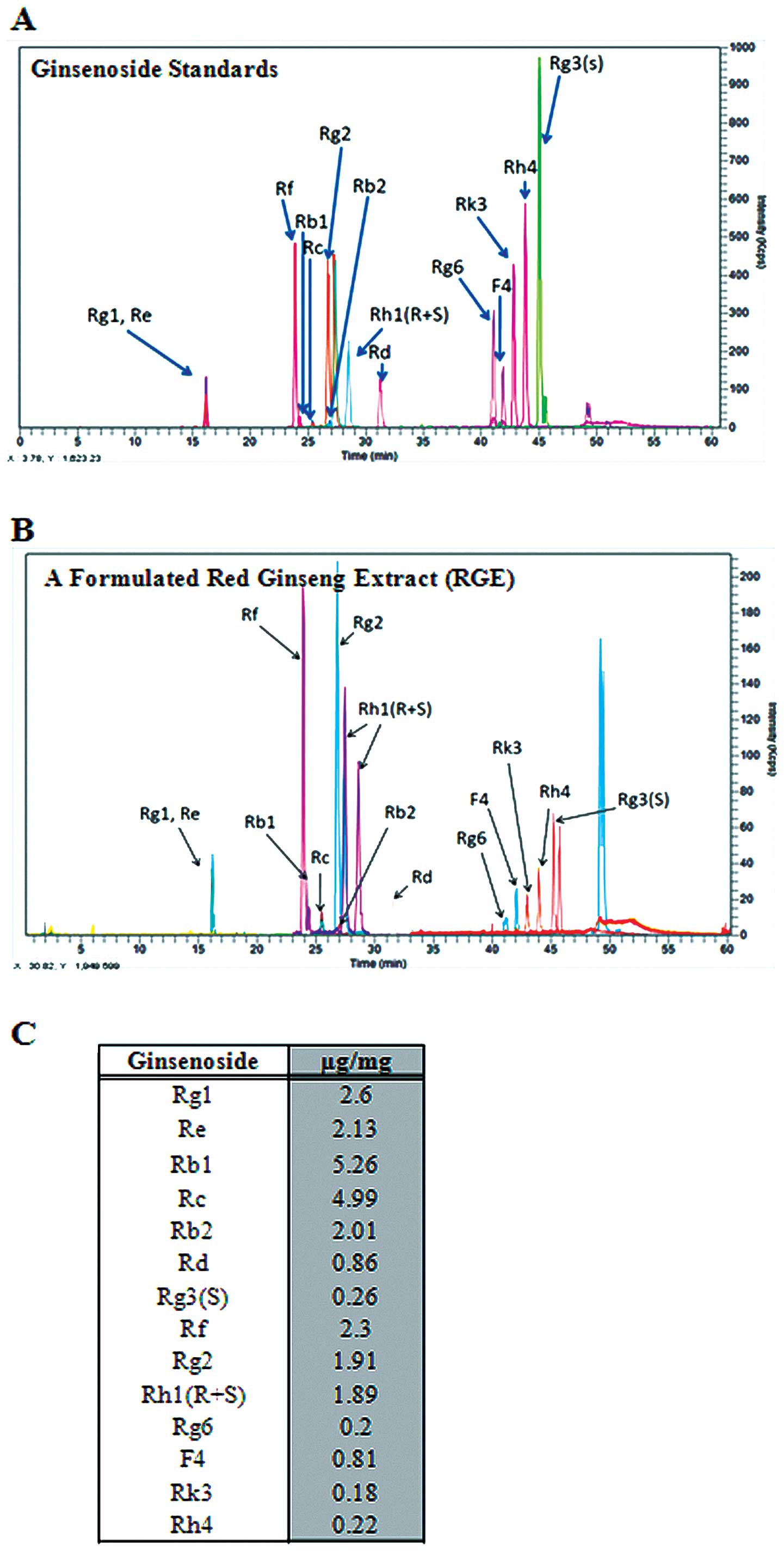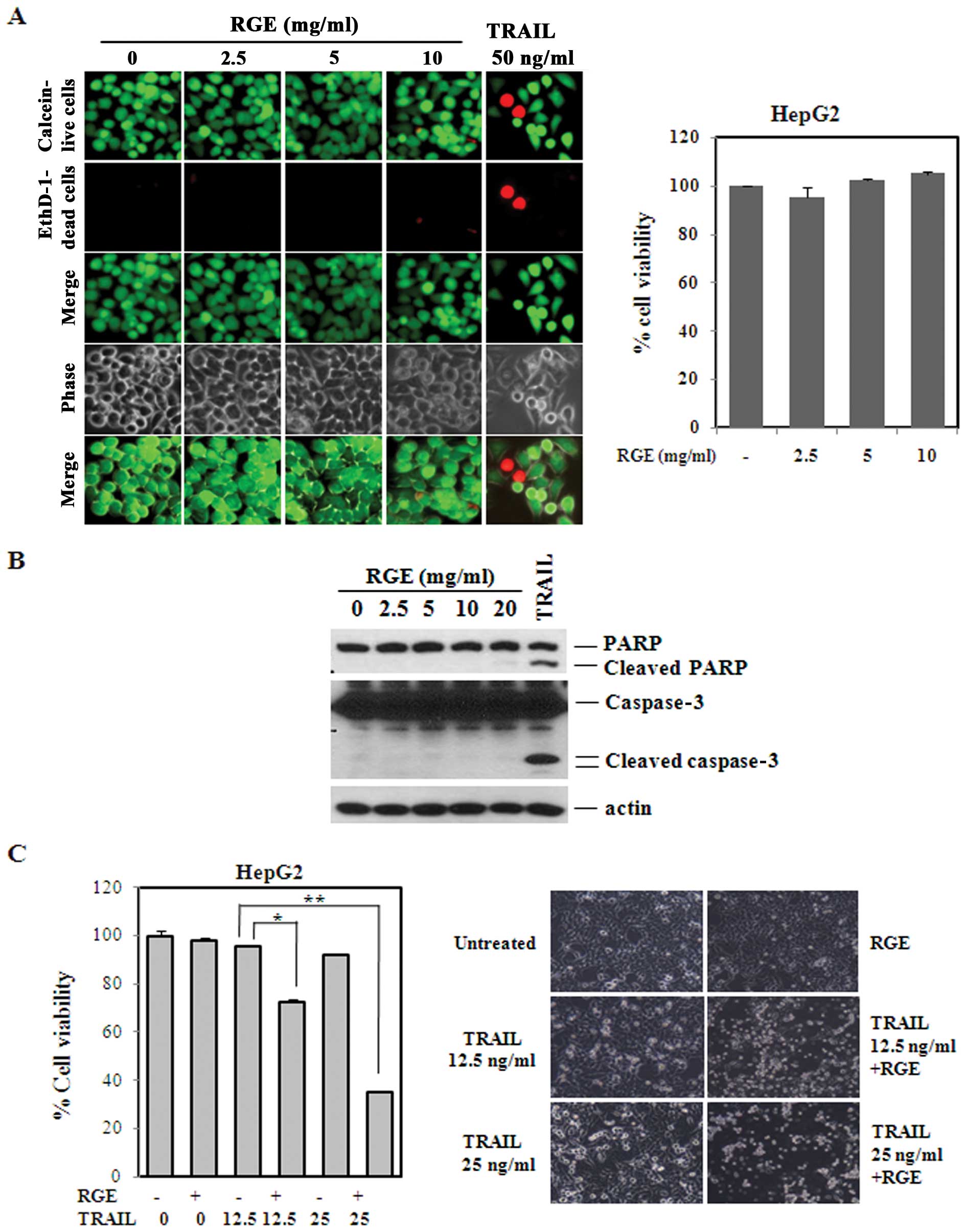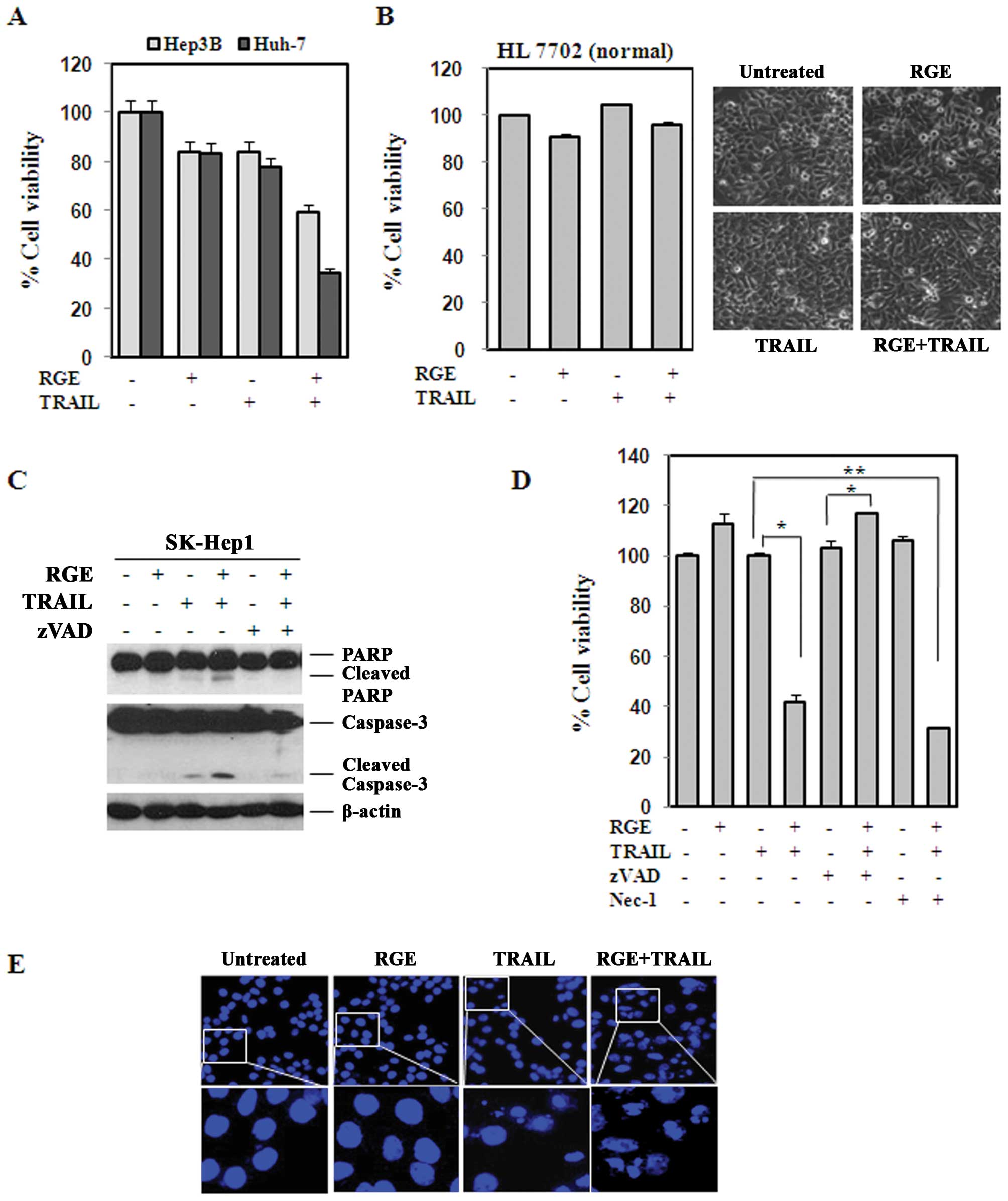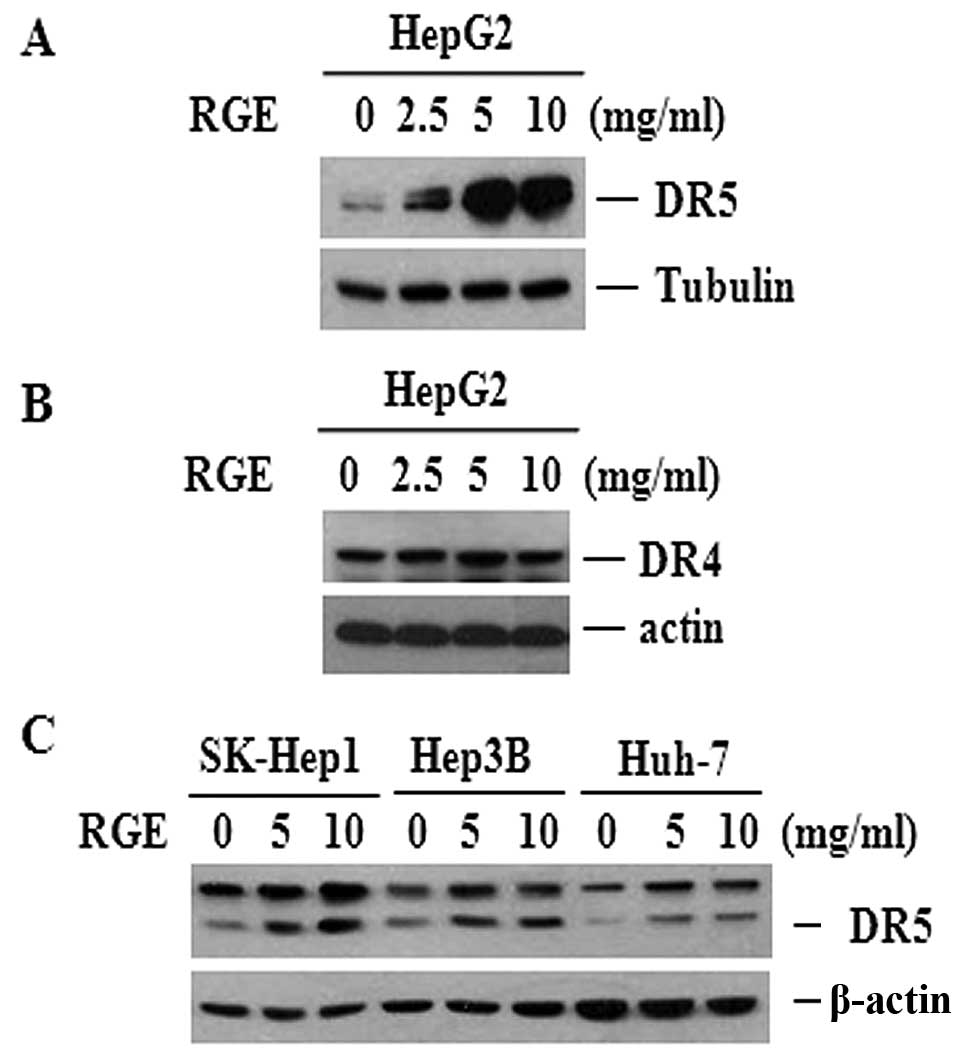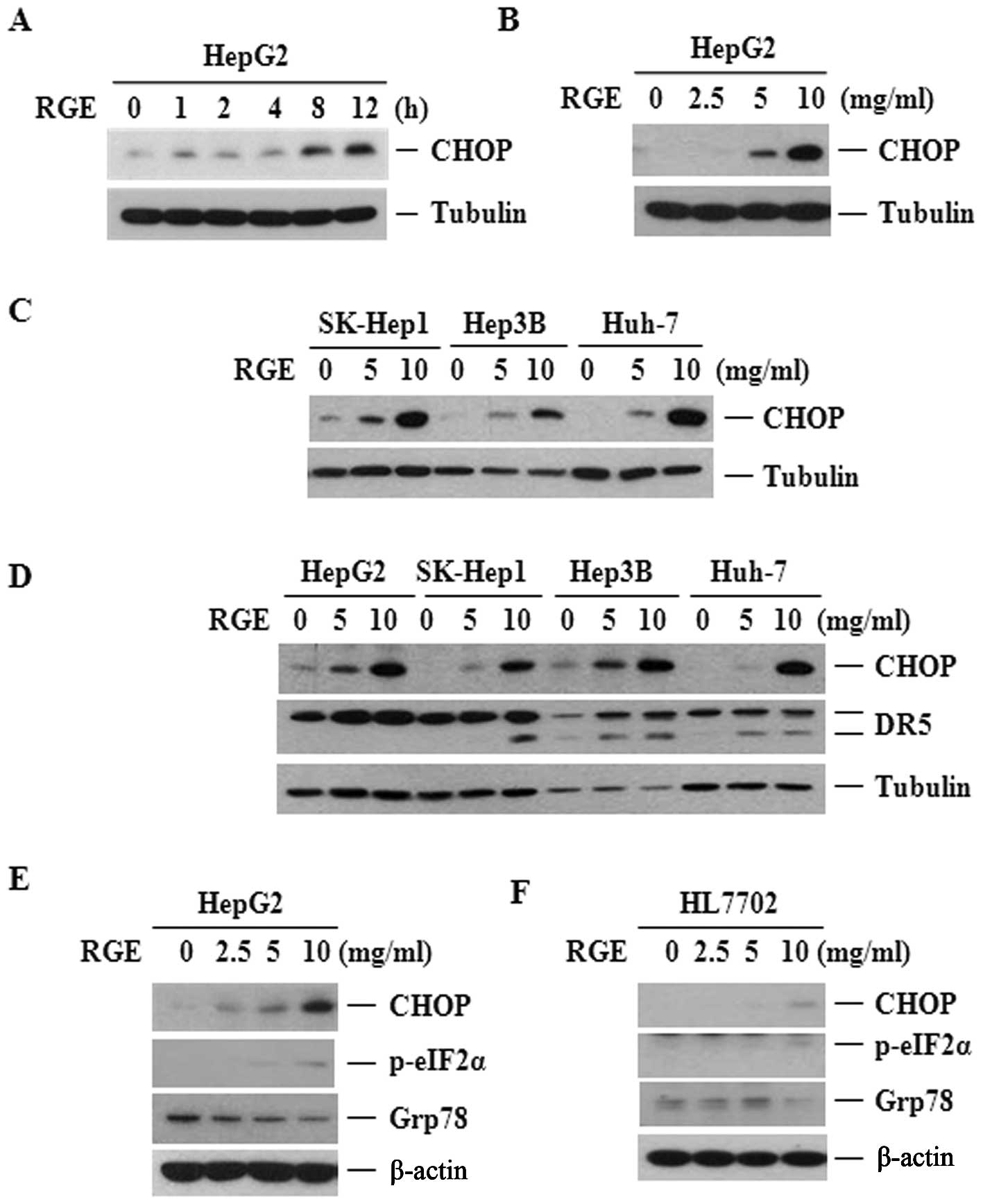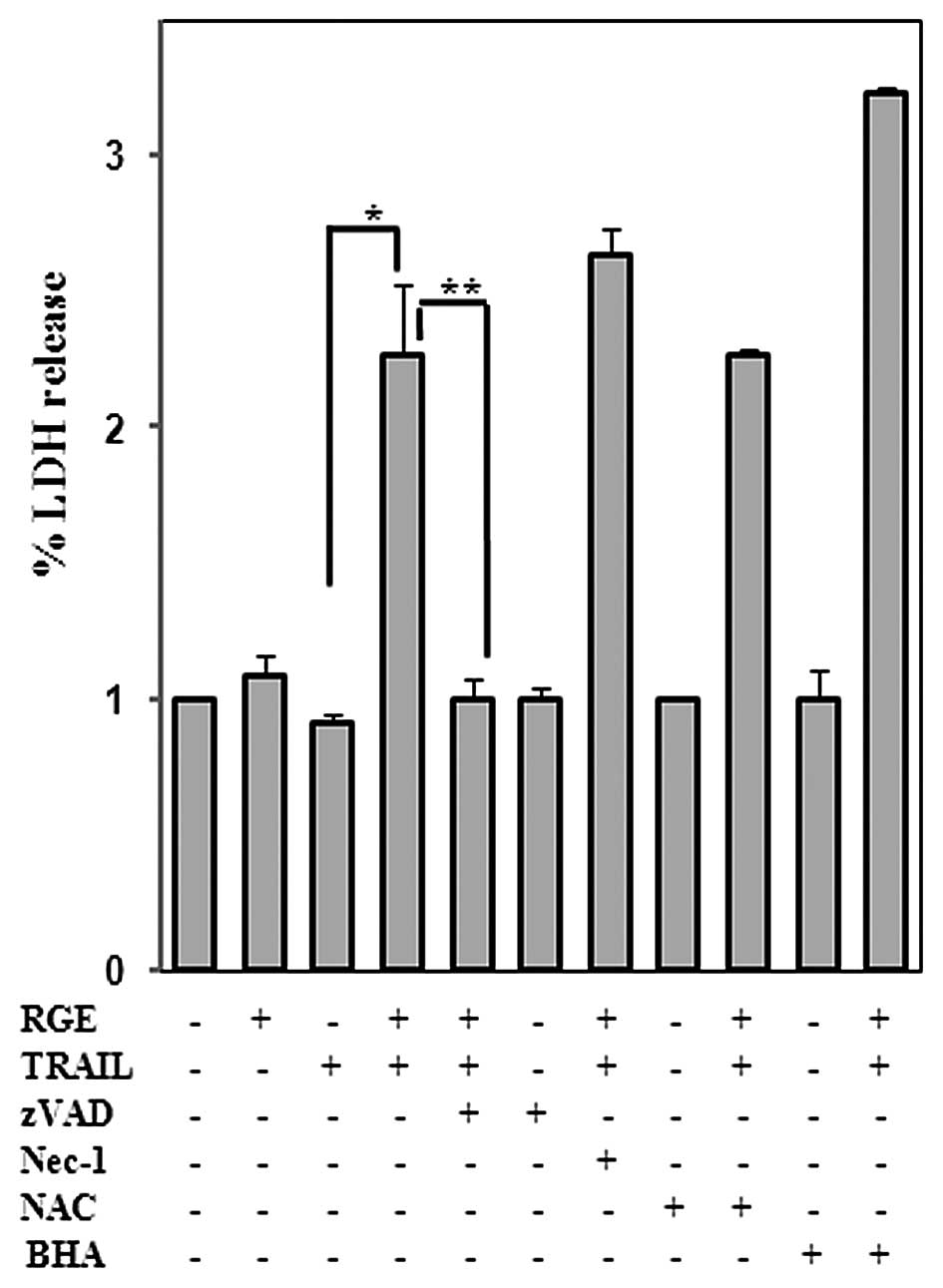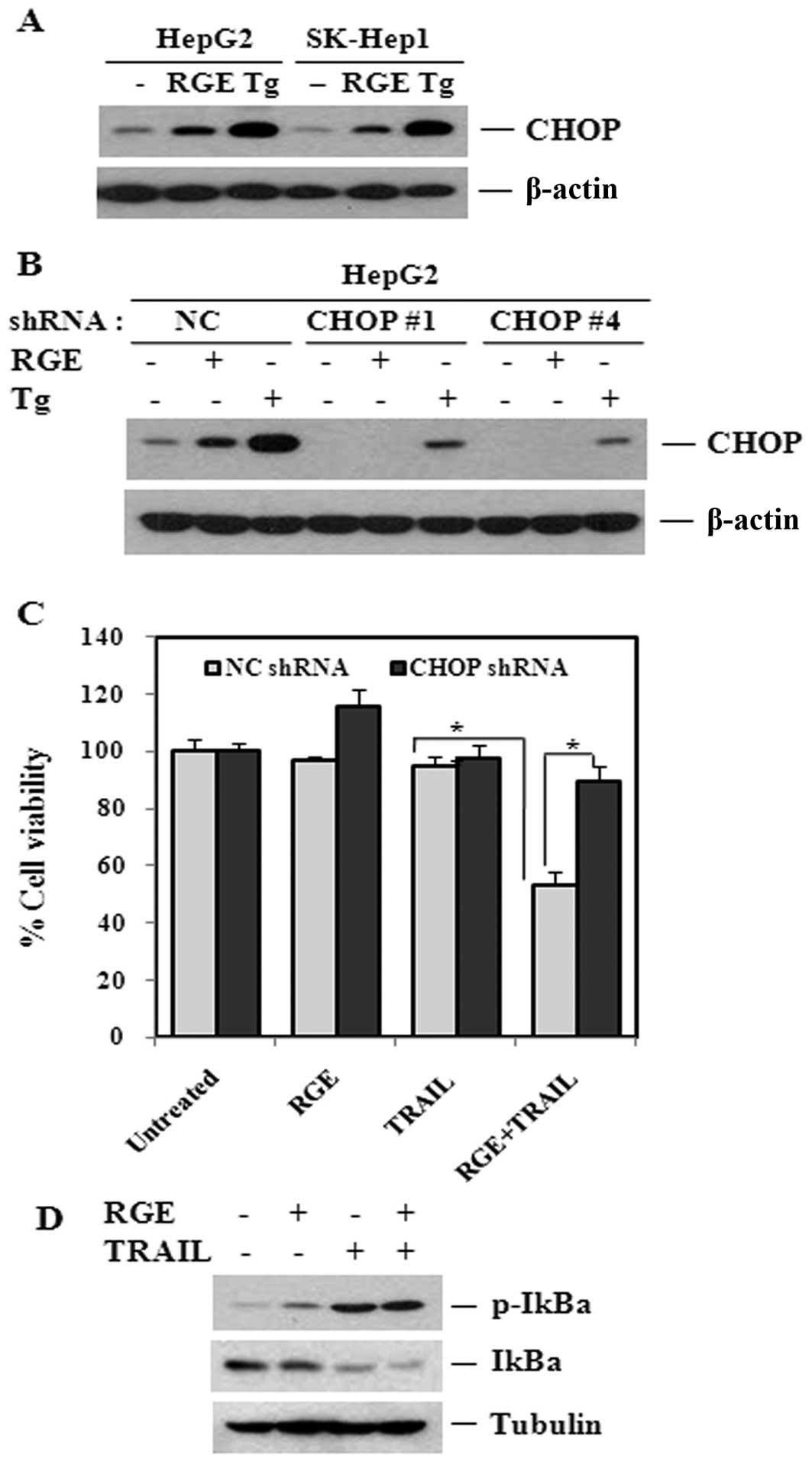A formulated red ginseng extract upregulates CHOP and increases TRAIL-mediated cytotoxicity in human hepatocellular carcinoma cells
- Authors:
- Published online on: May 27, 2013 https://doi.org/10.3892/ijo.2013.1964
- Pages: 591-599
Abstract
Introduction
TRAIL, also known as Apo2L and TNFSF10, belongs to the tumor necrosis factor (TNF) superfamily that induces cell death in various types of cancer cell lines in vivo and in vitro but has little or no effect on normal cell lines. The cytotoxic effects of TRAIL are carried out by its functional receptors, death receptor 4 (DR4) and death receptor 5 (DR5) (also known as TRAIL-R1 and TRAIL-R2), and death inducing signaling complex (DISC). DISC formation involves recruitment of an adaptor molecule, Fas-associated death domain (FADD), as well as apical caspase-8 and caspase-10. DISC assembly results in the auto-catalytic activation of caspase-8 and caspase-10, which initiates the caspase cascade, leading to apoptosis (1,2). Upon binding to DR4 and DR5, TRAIL activates the nuclear factor (NF)-κB and JNK signaling pathways (3). NF-κB plays an important role regulating anti- and pro-apoptotic events, depending on the physiological environment (4). NF-κB mediates the expression of anti-apoptotic genes, such as members of the inhibitor of apoptosis (IAP) family (cIAP-1 and -2 and XIAP), cellular Flice-like inhibitory proteins (c-FLIP) and Bcl-2, all of which determine susceptibility to TRAIL-derived apoptosis (5,6).
TRAIL is regarded as a promising anticancer agent because of its selective cytotoxicity against transformed cell lines; however, the potential clinical use of TRAIL has been blocked because some tumor cell lines become resistant to TRAIL-derived apoptosis (7,8). Resistance is generally induced by low expression of DR4/DR5 or high expression of IAP family members (8,9); thus, the discovery of agents that alleviate TRAIL resistance may allow the use of combined TRAIL-based therapeutic regimens to treat resistant cancers (10). Recombinant human TRAIL and several agonistic monoclonal antibodies are currently in phase II clinical trials. The agonistic antibodies include mapatumumab, which targets DR4, and lexatumumab, apomab, AMG655, CS-1008, and LBY-135, which target DR5 (11). However, increasing evidence indicates that death receptor agonists alone may not be sufficient to effectively activate apoptosis in many cancers.
Chemotherapy is not a standard treatment for hepatocellular carcinoma (HCC), and HCC is highly resistant to other conventional anti-neoplastic agents (12,13). Recent studies have shown that many cancer cell lines are not susceptible to the cytotoxic effects of TRAIL (14); thus, the discovery of agents that alleviate TRAIL resistance may be useful for the establishment of TRAIL-based combined regimens for improved HCC treatment.
A formulated red ginseng extract (RGE) derived from heat-processed Panax ginseng C.A. Meyer, is a functional food and dietary supplement consumed worldwide and is used in traditional oriental medicine to increase energy and life expectancy. RGE has been reported to reduce fatigue and to possess antioxidant and antitumor activities (15–17). Ginseng has been reported to possess antioxidant, antistress and immune-stimulating activities. These activities require the scavenging of hydroxyl, 1-1-diphenyl-2-picryhydrazyl (DPPH) and superoxide radicals to decrease lipid peroxidation through chelation of transition metal ions and to reduce oxidative DNA damage caused by the Fenton reaction or UV light exposure (18). Ginseng saponins also protect human low-density lipoproteins from oxidative damage in vitro (19) and induce Cu/Zn-superoxide dismutase expression at the transcriptional level (20).
Findings indicate that the RGE could be useful as a dietary supplement in a combined cancer treatment, as it sensitizes human HCC cell lines to TRAIL-derived cell death via a mechanism involving upregulation of DR5, which then enhances activation of the extrinsic apoptosis pathway. In this case, upregulation of DR5 is induced by C/EBP homologous (CHOP), an endoplasmic reticulum (ER) stress responsive element. shRNA-mediated downregulation of CHOP expression effectively suppresses cell death induced by RGE plus TRAIL in HepG2 cells, indicating that CHOP is essential for RGE-triggered enhancement of TRAIL-derived apoptosis. To summarize, data from the present study suggest that RGE may sensitize cells to TRAIL, thereby diminishing their resistance. RGE could be combined with TRAIL in a cocktail for use as a novel therapeutic strategy to more effectively treat HCC.
Materials and methods
Reagents
The following reagents were purchased and used according to the manufacturer’s instructions: glutathione S-transferase (GST)-TRAIL and anti-DR5 antibodies were from Koma Biotechnologies (Seoul, Korea); anti-caspase 3, anti-PARP and anti-CHOP antibodies were from Cell Signaling Technology; anti-DR4 antibody was from Rockland; anti-tubulin antibody was from Abcam; anti-actin antibody, thapsigargin (Tg), necrostatin-1, NAC and BHA were from Sigma; and zVAD was from R&D Systems. A formulated RGE was provided by the Korea Ginseng Corporation (Seoul, Korea).
Cell culture
The SK-Hep1, HepG2 and Hep3B cell lines were grown on culture plates in Dulbecco’s modified Eagle’s medium supplemented with 10% fetal bovine serum (FBS), 2 mM glutamine, 100 U/ml penicillin and 100 μg/ml streptomycin. Huh-7 cells were grown on culture plates in RPMI-1640 medium supplemented with 10% FBS, 2 mM glutamine, 100 U/ml penicillin and 100 μg/ml streptomycin. A commercially available normal liver cell line (HL-7702) was grown on culture plates in RPMI-1640 medium supplemented with 20% FBS, 2 mM glutamine, 100 U/ml penicillin and 100 μg/ml streptomycin.
Western blot analysis
Upon treatment, cell lines were lysed in 20 mM Tris (pH 7.0), 250 mM NaCl, 3 mM EDTA, 3 mM EGTA, 2 mM DTT, 0.5% NP-40, 0.5 mM PMSF, 20 mM β-glycerol phosphate, 1 mM sodium vanadate and 1 μg/ml leupeptin. Lysates were loaded onto 10 or 12% SDS-PAGE gels. Following transfer and blotting, the proteins of interest were visualized by enhanced chemiluminescence (ECL, Pierce) and analyzed.
Cytotoxicity assays
Viable cells were measured by the MTT assay (dual labeling method with 2 μM calcein-AM and 4 μM EthD-1), and MTT absorbance was read at 570 nm. Lactate dehydrogenase (LDH) leakage was quantified using a cytotoxicity detection kit (Promega). Images were recorded by microscope and the data presented are from at least three independent experiments.
Lentiviral shRNA experiments
shRNA-encoding plasmids were purchased from Sigma-Aldrich, and the targets were coding region sequences or the 3′ untranslated region of CHOP mRNA (NM: 004083). The 293T cell line (LV900A-1) was transfected with lentiviral plasmids using Lipofectamine 2000 transfection reagent (Invitrogen, 11668019). HepG2 cell lines were infected with pseudoviral particles collected from the 293T cell line 2 days after transfection in the presence of Polybrene (8 μg/ml). The lentivirus-infected HepG2 cell line was then isolated by puromycin (1 μg/ml) resistance 2 days after infection, and knockdown of CHOP was confirmed by western blot analysis. CHOP knockdown cell lines were seeded on 6-well plates and treated with the RGE or Tg for the times indicated for each experiment and were analyzed by western blot analysis.
Results and Discussion
Analysis of the formulated RGE
A high-performance liquid chromatography/mass spectrometry (LC/MS) method was used for the targeted 14 ginsenosides to determine the ginsenoside content in the formulated RGE. Butanol extracts of white, red and sun ginseng were employed to isolate the standard ginsenosides, and each ginsenoside was isolated and purified by silica gel chromatography or preparative LC (21,22). Calibration curves for each ginsenoside standard were plotted (data not shown), and the ginsenoside contents of the formulated RGE were calculated (Fig. 1, Table I). Korean red ginseng has been reported to induce antitumor and immune-stimulating, antistress and antioxidant activities. The cytoprotective and chemoprotective properties of ginseng have been attributed to its ability to reduce oxidative or nitrosative stress (23–25). Previous studies have suggested that RGE, a major component of ginseng, inhibits cancer cell propagation and metastasis (24). Based on these observations, we tested the cytotoxicity of the RGE in the HepG2 cell lines. As shown in Fig. 2A, RGE concentrations up to 10 mg/ml showed no significant effects on cells (left panel) and no decrease in viability, as measured by LDH release (right panel). As a positive control, we treated the HepG2 cell lines with TRAIL (50 ng/ml) and observed the induction of cell death, as evidenced by the EthD-1-positive cell line. We found that TRAIL (25 ng/ml) induced poly (ADP-ribose) polymerase (PARP) cleavage at 12 h, but that the RGE alone had little effect on PARP and caspase-3 cleavage (Fig. 2B).
TRAIL-derived cell death was augmented in the HCC cell lines by pretreatment with the RGE
Because our data suggested that the RGE alone has no obvious effect on cancer cell cytotoxicity, we then measured the sensitization effect of the RGE on TRAIL-derived cell death. When the RGE and TRAIL were added to cells consecutively, dramatic cell death occurred according to the results of the MTT colorimetric assay (Fig. 2C). Concentrations of TRAIL >50 ng/ml were required to induce significant cytotoxicity; however, concentrations of TRAIL <25 ng/ml showed minimal cytotoxicity. Viability measurements from concentration curves obtained from 1:2 serial dilutions demonstrated that 10 mg/ml of the RGE was necessary to achieve robust TRAIL-derived cell death (data not shown), but RGE alone showed a minimal cytotoxic effect. We further tested the sensitization effect in the Hep3B and Huh-7 cell lines. A similar degree of TRAIL (25 ng/ml) sensitization was observed, indicating that this effect was universal in HCC cell lines (Fig. 3A). In contrast, a combination of the RGE and TRAIL sensitize normal human liver cell lines, confirming that this sensitization was specific to the tumor cell lines (Fig. 3B).
One of the primary problems when clinically applying TRAIL as a cancer therapeutic agent is resistance. One effective strategy to surmount this issue would be to discover anticancer agents for use in combination therapy (26–29). Several natural products and other chemical compounds have been identified that sensitize cancer cell lines to TRAIL-derived apoptosis. In this study, we tested a formulated RGE that has been suggested to possess anticancer properties and the results provide substantial evidence that the RGE was capable of sensitizing HCC to TRAIL-derived apoptosis by upregulating the CHOP, which then induced DR5 expression.
Sensitization effect of the RGE in TRAIL-derived cell death is caspase-dependent
We next examined the effects of the RGE on TRAIL activation of the caspase cascade in the SK-Hep1 cell line. As shown in Fig. 3C, treatment with a combination of RGE and TRAIL induced cleavage of caspase-3 and PARP, a well-established caspase substrate, whereas treatment with the RGE alone did not. In addition, cell death was apoptotic because necrostatin-1 failed to inhibit cell death, as shown in Fig. 3D. To further confirm RGE and TRAIL-derived apoptosis, cells were cultured on coverslips and treated with RGE, TRAIL or RGE plus TRAIL. The cells were fixed and stained with DAPI after 16–18 h, and examined for morphologic changes such as nuclear DNA fragmentation and/or condensation, which are indicative of apoptotic death. As shown in Fig. 3E, the RGE alone had no clear effect on nuclear DNA fragmentation and/or condensation, but RGE pretreatment significantly augmented TRAIL-derived nuclear DNA fragmentation and/or condensation in HepG2 cells.
RGE induces upregulation of DR5 expression
TRAIL resistance is facilitated by the downregulation of DR4 and DR5 and upregulation of DcR1 and DcR2 (8,30–32). We examined TRAIL receptor protein levels in cells treated with the RGE to explore the molecular mechanisms underlying the sensitization effect of the RGE to TRAIL-derived cell death. Treatment with the RGE significantly increased the expression of DR5 in a dose-dependent manner in HepG2 cells (Fig. 4A), although no clear changes were found in DR4 expression (Fig. 4B). We compared the effects of the RGE in three different HCC cell lines to determine whether this effect was cell-type specific (Fig. 4C). All cell lines tested showed upregulated DR5 expression following the RGE treatment, suggesting that the effects of RGE on the upregulation of DR5 are not cell-type specific.
Many mechanisms have been elucidated for inducing DR5, including ER stress, p53 induction, reactive oxygen species (ROS) generation and NF-κB/MAPK activation (33–35). It has been suggested that C/EBP homologous protein/GADD153, a transcription factor of the C/EBP family that has a role in ER stress, is involved in activating DR5 expression and thus contributes to the effectiveness of the RGE and TRAIL combined therapy (36–38). The RGE treatment increased CHOP levels in the HepG2 cell lines corresponding to its sensitization effect on TRAIL-derived cell death (Fig. 5A–C). As shown in Fig. 5D, RGE-induced CHOP upregulation preceded the increase in DR5 levels. Such a temporal pattern further supports the notion that CHOP plays a role in the activation of DR5 expression by the RGE. As CHOP is a major transcription factor induced by ER stress, we examined whether RGE treatment would induce ER stress in HCC. Thus, we probed for two markers of ER stress: Ser-51 phosphorylation of eIF2α (P-eIF2α) and induction of the ER chaperone protein GRP78. As shown in Fig. 5E, the RGE upregulated C/EBP homologous protein but did not induce GRP78 or eIF2α phosphorylation in the HepG2 cell lines, indicating that the RGE was capable of over-expressed the CHOP without substantively affecting ER stress. However, the RGE did not influence CHOP expression in the normal liver cell lines, which strongly agrees with the observation that the RGE did not boost the effect of TRAIL in the normal cell lines (Fig. 3B). Additionally, the RGE was unable to induce expression of the C/EBP homologous protein or other ER stress markers in the normal cell lines (Fig. 5F).
When investigating the induction of the TRAIL receptors DR4 and DR5 in tumors it is very important to assess susceptibility of the tumor to TRAIL treatment (39). Several studies have shown that high expression of the TRAIL receptors DR4 and DR5 facilitates sensitization of cancer cells to TRAIL-derived cell death (1,40). One therapeutic approach being tested is to induce the expression of death receptors, including DR4 and particularly DR5, by small molecules, which results in TRAIL-derived tumor cell death or sensitization of TRAIL-resistant cell lines to cell death (33). Furthermore, DR5 expression levels are highly correlated with TRAIL, which binds to its receptors, DR4 and DR5, and activates the extrinsic apoptosis pathway (34,41,42). In the present study, we found that the improved effects of the combination therapy were primarily dependent upon control of DR5 induction. We also found that the combination therapy induced apoptosis in the presence of ROS (Fig. 6), suggesting that ROS do not contribute to RGE-facilitated sensitization of TRAIL-derived cell death.
Increased expression of CHOP is related to DR5 upregulation
Tg treatment was compared with RGE treatment to confirm that upregulation of CHOP plays a key role in the RGE sensitization effect, as shown in Fig. 7A(43,44). Next, we established stable cell lines for knockdown of the C/EBP homologous protein using a lentiviral shRNA system. As shown in Fig. 7B, we confirmed knockdown of CHOP. In addition, knockdown of CHOP inhibited the robust upregulation of CHOP induced by Tg. We then examined the effect of CHOP knockdown on RGE-induced sensitization to TRAIL-derived cell death. CHOP knockdown inhibited the effect of the RGE plus TRAIL treatment in HepG2 cell lines, suggesting that augmentation of cell death by the RGE combined treatment in HCC was mediated by CHOP expression (Fig. 7C).
Activation of NF-κB in cancer cell lines contributes to the induction of DR5 as well as resistance to TRAIL-derived apoptosis. Therefore, we examined whether the RGE might regulate NF-κB to facilitate DR5 upregulation and, consequently, sensitize cell lines to TRAIL-derived apoptosis. As shown in Fig. 7D, degradation and phosphorylation of IκBα did not occur in response to the RGE. In addition, the RGE did not affect TRAIL-derived NF-κB activation, suggesting that RGE-induced sensitization to cell death is not mediated by NF-κB. Although TRAIL is capable of activating NF-κB in some cancer cell lines and the induction of DR5 is linked to NF-κB activation, activated NF-κB also upregulates the anti-apoptotic gene Bcl-xL, effectively blocking TRAIL-derived apoptosis (10,27,34). We failed to detect upregulation of Bcl-xL in response to RGE treatment (data not shown), which further indicates that NF-κB was activated by the RGE. Additionally, RGE-induced CHOP upregulation was not caused by ER stress, which can lead to apoptosis in HCC cell lines. Inducing CHOP expression or TRAIL sensitization was unsuccessful when RGE was applied to the normal cell line HL7702, suggesting that CHOP protein upregulation by the RGE is specific to the tumor cell lines.
Although we have not tested the antitumor activity of the RGE in vivo, the formulated RGE examined could potentially be further developed as an important chemosensitizer to be utilized as a dietary supplement with anticancer drugs.
Acknowledgements
This study was supported by the 2011 grant from the Korean Society of Ginseng funded by Korea Ginseng Corporation and the Yujeonja-Donguibogam project based on Traditional herbs (Grant No. 2012M3A9C4048796), Republic of Korea. This study was also supported by a National Research Foundation of Korea (NRF) grant funded by the Korean government (2011-0030834) to Y.-S. Kim and by the 2010 grant from Department of Medical Sciences, the Graduate School, Ajou University.
References
|
Kischkel FC, Lawrence DA, Chuntharapai A, Schow P, Kim KJ and Ashkenazi A: Apo2L/TRAIL-dependent recruitment of endogenous FADD and caspase-8 to death receptors 4 and 5. Immunity. 12:611–620. 2000. View Article : Google Scholar : PubMed/NCBI | |
|
Deveraux QL, Roy N, Stennicke HR, et al: IAPs block apoptotic events induced by caspase-8 and cytochrome c by direct inhibition of distinct caspases. EMBO J. 17:2215–2223. 1998. View Article : Google Scholar : PubMed/NCBI | |
|
Hu W, Johnson H and Shu H: Tumor necrosis factor-related apoptosis-inducing ligand receptors signal NF-κB and JNK activation and apoptosis through distinct pathways. J Biol Chem. 274:306031999. | |
|
Lin B, Williams-Skipp C, Tao Y, et al: NF-κB functions as both a proapoptotic and antiapoptotic regulatory factor within a single cell type. Cell Death Differ. 6:570–582. 1999. | |
|
Son YG, Kim EH, Kim JY, et al: Silibinin sensitizes human glioma cells to TRAIL-mediated apoptosis via DR5 up-regulation and down-regulation of c-FLIP and survivin. Cancer Res. 67:8274–8284. 2007. View Article : Google Scholar : PubMed/NCBI | |
|
Ding L, Yuan C, Wei F, et al: Cisplatin restores TRAIL apoptotic pathway in glioblastoma-derived stem cells through up-regulation of DR5 and down-regulation of c-FLIP. Cancer Invest. 29:511–520. 2011. View Article : Google Scholar : PubMed/NCBI | |
|
Park SJ, Bijangi-Vishehsaraei K and Safa AR: Selective TRAIL-triggered apoptosis due to overexpression of TRAIL death receptor 5 (DR5) in P-glycoprotein-bearing multidrug resistant CEM/VBL1000 human leukemia cells. Int J Biochem Mol Biol. 1:90–100. 2010. | |
|
Fossati S, Ghiso J and Rostagno A: TRAIL death receptors DR4 and DR5 mediate cerebral microvascular endothelial cell apoptosis induced by oligomeric Alzheimer’s Aβ. Cell Death Dis. 3:e3212012.PubMed/NCBI | |
|
Griffith TS, Fialkov JM, Scott DL, et al: Induction and regulation of tumor necrosis factor-related apoptosis–inducing ligand/Apo-2 ligand-mediated apoptosis in renal cell carcinoma. Cancer Res. 62:3093–3099. 2002. | |
|
Kim JY, Lee JY, Kim DG, Koo GB, Yu JW and Kim YS: TRADD is critical for resistance to TRAIL-induced cell death through NF-κB activation. FEBS Lett. 585:2144–2150. 2011. | |
|
Tian X, Ye J, Alonso-Basanta M, Hahn SM, Koumenis C and Dorsey JF: Modulation of CCAAT/enhancer binding protein homologous protein (CHOP)-dependent DR5 expression by nelfinavir sensitizes glioblastoma multiforme cells to tumor necrosis factor-related apoptosis-inducing ligand (TRAIL). J Biol Chem. 286:29408–29416. 2011. View Article : Google Scholar | |
|
Carr BI: Hepatocellular carcinoma: current management and future trends. Gastroenterology. 127:S218–S224. 2004. View Article : Google Scholar : PubMed/NCBI | |
|
Yang JF, Cao JG, Tian L and Liu F: 5,7-Dimethoxyflavone sensitizes TRAIL-induced apoptosis through DR5 upregulation in hepatocellular carcinoma cells. Cancer Chemother Pharmacol. 69:195–206. 2012. View Article : Google Scholar : PubMed/NCBI | |
|
Zhang B, Shan H, Li D, et al: Cisplatin sensitizes human hepatocellular carcinoma cells, but not hepatocytes and mesenchymal stem cells, to TRAIL within a therapeutic window partially depending on the upregulation of DR5. Oncol Rep. 25:461–468. 2011. | |
|
Lee SA, Jo HK, Im BO, Kim SU, Whang WK and Ko SK: Changes in the Contents of Prosapogenin in the Red Ginseng (Panax ginseng) Depending on Steaming Batches. J Ginseng Res. 36:102–106. 2012. View Article : Google Scholar : PubMed/NCBI | |
|
In G, Ahn NG, Bae BS, Han ST, Noh KB and Kim CS: New method for simultaneous quantification of 12 ginsenosides in red ginseng powder and extract: in-house method validation. J Ginseng Res. 36:205–210. 2012. View Article : Google Scholar : PubMed/NCBI | |
|
Sun S, Qi LW, Du GJ, Mehendale SR, Wang CZ and Yuan CS: Red notoginseng: higher ginsenoside content and stronger anti-cancer potential than Asian and American ginseng. Food Chem. 125:1299–1305. 2011. View Article : Google Scholar : PubMed/NCBI | |
|
Keum YS, Park KK, Lee JM, et al: Antioxidant and anti-tumor promoting activities of the methanol extract of heat-processed ginseng. Cancer Lett. 150:41–48. 2000. View Article : Google Scholar : PubMed/NCBI | |
|
Li J, Huang M, Teoh H and Man RY: Panax quinquefolium saponins protects low density lipoproteins from oxidation. Life Sci. 64:53–62. 1999. View Article : Google Scholar : PubMed/NCBI | |
|
Chang MS, Lee SG and Rho HM: Transcriptional activation of Cu/Zn superoxide dismutase and catalase genes by panaxadiol ginsenosides extracted from Panax ginseng. Phytother Res. 13:641–644. 1999. View Article : Google Scholar | |
|
Ji HY, Lee HW, Kim HK, et al: Simultaneous determination of ginsenoside Rb(1) and Rg(1) in human plasma by liquid chromatography-mass spectrometry. J Pharm Biomed Anal. 35:207–212. 2004. View Article : Google Scholar : PubMed/NCBI | |
|
Cai F, Sun L, Gao S, Yang Y, Yang Q and Chen W: A rapid and sensitive liquid chromatography-tandem mass spectrometric method for the determination of timosaponin B-II in blood plasma and a study of the pharmacokinetics of saponin in the rat. J Pharm Biomed Anal. 48:1411–1416. 2008. View Article : Google Scholar : PubMed/NCBI | |
|
Woo SS, Song JS, Lee JY, et al: Selection of high ginsenoside producing ginseng hairy root lines using targeted metabolic analysis. Phytochemistry. 65:2751–2761. 2004. View Article : Google Scholar : PubMed/NCBI | |
|
Park JD, Rhee DK and Lee YH: Biological activities and chemistry of saponins from Panax ginseng CA Meyer. Phytochem Rev. 4:159–175. 2005. View Article : Google Scholar | |
|
Lee DCW and Lau ASY: Effects of Panax ginseng on tumor necrosis factor-α-mediated inflammation: a mini-review. Molecules. 16:2802–2816. 2011. | |
|
Sayers TJ: Targeting the extrinsic apoptosis signaling pathway for cancer therapy. Cancer Immunology, Immunotherapy. 1–8. 2011. | |
|
Ravi R, Bedi GC, Engstrom LW, et al: Regulation of death receptor expression and TRAIL/Apo2L-induced apoptosis by NF-κB. Nat Cell Biol. 3:409–416. 2001. | |
|
Ganten TM, Koschny R, Sykora J, et al: Preclinical differentiation between apparently safe and potentially hepatotoxic applications of TRAIL either alone or in combination with chemotherapeutic drugs. Clin Cancer Res. 12:2640–2646. 2006. View Article : Google Scholar | |
|
Baritaki S, Huerta-Yepez S, Sakai T, Spandidos DA and Bonavida B: Chemotherapeutic drugs sensitize cancer cells to TRAIL-mediated apoptosis: up-regulation of DR5 and inhibition of Yin Yang 1. Mol Cancer Ther. 6:1387–1399. 2007. View Article : Google Scholar : PubMed/NCBI | |
|
Mellier G, Huang S, Shenoy K and Pervaiz S: TRAILing death in cancer. Mol Aspects Med. 31:93–112. 2010. View Article : Google Scholar | |
|
Kouhara J, Yoshida T, Nakata S, et al: Fenretinide upregulates DR5/TRAIL-R2 expression via the induction of the transcription factor CHOP and combined treatment with fenretinide and TRAIL induces synergistic apoptosis in colon cancer cell lines. Int J Oncol. 30:679–687. 2007. | |
|
Bertram H, Nerlich A, Omlor G, Geiger F, Zimmermann G and Fellenberg J: Expression of TRAIL and the death receptors DR4 and DR5 correlates with progression of degeneration in human intervertebral disks. Mod Pathol. 22:895–905. 2009. View Article : Google Scholar : PubMed/NCBI | |
|
Xiaowen H and Yi S: Triptolide sensitizes TRAIL-induced apoptosis in prostate cancer cells via p53-mediated DR5 up-regulation. Mol Biol Rep. 39:8763–8770. 2012. View Article : Google Scholar : PubMed/NCBI | |
|
Lin FL, Hsu JL, Chou CH, Wu WJ, Chang CI and Liu HJ: Activation of p38 MAPK by damnacanthal mediates apoptosis in SKHep 1 cells through the DR5/TRAIL and TNFR1/TNF-α and p53 pathways. Eur J Pharmacol. 650:120–129. 2011.PubMed/NCBI | |
|
Deng Z, Yan H, Hu J, et al: Hepatitis C virus sensitizes host cells to TRAIL-induced apoptosis by up-regulating DR4 and DR5 via a MEK1-dependent pathway. PloS One. 7:e377002012. View Article : Google Scholar : PubMed/NCBI | |
|
Shiraishi T, Yoshida T, Nakata S, et al: Tunicamycin enhances tumor necrosis factor-related apoptosis-inducing ligand-induced apoptosis in human prostate cancer cells. Cancer Res. 65:6364–6370. 2005. View Article : Google Scholar | |
|
Chen CY, Yiin SJ, Hsu JL, Wang WC, Lin SC and Chern CL: Isoobtusilactone A sensitizes human hepatoma Hep G2 cells to TRAIL-induced apoptosis via ROS and CHOP-mediated up-regulation of DR5. J Agric Food Chem. 60:3533–3539. 2012. View Article : Google Scholar : PubMed/NCBI | |
|
Oyadomari S and Mori M: Roles of CHOP/GADD153 in endoplasmic reticulum stress. Cell Death Differ. 11:381–389. 2003. View Article : Google Scholar : PubMed/NCBI | |
|
Bin L, Thorburn J, Thomas LR, Clark PE, Humphreys R and Thorburn A: Tumor-derived mutations in the TRAIL receptor DR5 inhibit TRAIL signaling through the DR4 receptor by competing for ligand binding. J Biol Chem. 282:28189–28194. 2007. View Article : Google Scholar : PubMed/NCBI | |
|
Sheridan JP, Marsters SA, Pitti RM, et al: Control of TRAIL-induced apoptosis by a family of signaling and decoy receptors. Science. 277:818–821. 1997. View Article : Google Scholar : PubMed/NCBI | |
|
Seol DW: p53-Independent up-regulation of a TRAIL receptor DR5 by proteasome inhibitors: a mechanism for proteasome inhibitor-enhanced TRAIL-induced apoptosis. Biochem Biophys Res Commun. 416:222–225. 2011. View Article : Google Scholar : PubMed/NCBI | |
|
Sung B, Ravindran J, Prasad S, Pandey MK and Aggarwal BB: Gossypol induces death receptor-5 through activation of the ROS-ERK-CHOP pathway and sensitizes colon cancer cells to TRAIL. J Biol Chem. 285:35418–35427. 2010. View Article : Google Scholar : PubMed/NCBI | |
|
Zinszner H, Kuroda M, Wang X, et al: CHOP is implicated in programmed cell death in response to impaired function of the endoplasmic reticulum. Genes Dev. 12:982–995. 1998. View Article : Google Scholar : PubMed/NCBI | |
|
Zou W, Yue P, Khuri F and Sun S: Coupling of endoplasmic reticulum stress to CDDO-Me-induced up-regulation of death receptor 5 via a CHOP-dependent mechanism involving JNK activation. Cancer Res. 68:7484–7492. 2008. View Article : Google Scholar : PubMed/NCBI |



